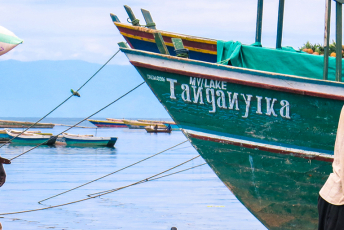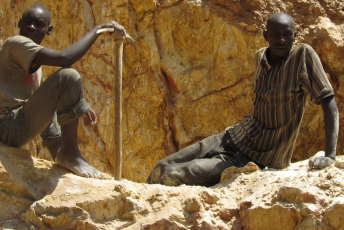Children are increasingly involved in sand mining in East Africa. The illegal sand trade takes place in mostly remote areas, hidden from sight and out of reach of anti-child labour advocacy campaigns. This makes it hard to determine the exact number of youngsters involved.
Mined sand is widely used in the construction industry – usually civil projects, in the case of that mined by children.
In Uganda, underage boys dredge sand from Lake Victoria and rivers for paltry wages. They use wooden canoes with no protective gear in these fast-moving waters, risking injury or death. Unrestored sand pits – large holes dug along pathways, the depth of which can be deceptive when they are filled with rainwater, especially at night – can be fatal to youngsters who are unaware of their locations. Police do not follow up on reports of children who have fallen into or drowned in these pits.
Along the Sirare-Isebania border of Tanzania and Kenya, sand cartels use children as labourers to dig sand out of pits. More join when schools close for the holidays in April, August and December, says Jacob Maluki, senior county and community engagement officer of the Athi Basin Area for Kenya’s Water Resources Authority.
In Zanzibar’s Mangapwani town and its adjacent villages, such as Bumbwini, children are moving away from selling coconuts to digging and selling sand. The income they receive from sand is steadier because of the demand from the hotel construction industry.
Factors driving children into sand mining are linked to economic hardship and unstable levels of family income. Families push their children into mining and selling sand in small quantities, says Halinishi Yusuf, managing director of the Makueni County Sand Conservation and Utilization Authority. One reason for this is because sand mining requires zero investment and is highly informal. As a loader, all you need is a spade to ensure a daily wage.
A child in Zanzibar can sell an ox cart of sand for US$1.70 (TSh4 000), earning instant cash. Other children work in unlicensed quarries operated by sand miners who sell three tonnes of sand for between US$30 and US$50 (TSh70 000 and TSh120 000) and pay the children meagre daily wages.
The COVID-19 pandemic exacerbated the problem in Kenya. The abrupt closure of schools for long periods, as well as parents losing incomes due to business disruption, saw children moving into the sand business. At Kaonyweni Secondary School in Kenya’s Machakos County, student numbers dropped from 115 to nine between 2019 and 2021, says Maluki. A similar trend was observed in other schools, such as Mbingoni Primary. Instead of being at school, children were mining sand in rivers. They haven’t returned.
Boys who drop out of school become assistants to the sand loaders. When they turn 18, they become loaders themselves. A loader in Kenya can make a decent wage of between US$30 and US$60 (KES3 000 and KES6 000) a day.
Underage girls, who are pressured by their families to earn an income from the sand trade, become involved by doing menial tasks, such as sharpening shovels or selling food to the labourers. They are also lured into commercial sex work, varied negative consequences are early pregnancies, an increase in sexually transmitted diseases and sexual violence.
The involvement of both boys and girls in mining activities generally, including coltan mining in the Democratic Republic of the Congo, is rampant in East African states. Despite the known harms, these countries are still in the infancy stages of developing comprehensive regulatory frameworks on sand extraction activities.
In Kenya, county governments are responsible for establishing regulatory frameworks for conserving the environment and all natural resources, including sand. Of Kenya’s 47 counties, only Makueni has established a policy framework comprising legislation and an implementing agency - the Makueni County Sand Conservation and Utilization Authority.
Yusuf points out that before 2015, when Makueni established its regulatory framework, children were embedded as sand workers, especially in areas such as Kilome and Kikuu. With new regulations requiring all sand workers to be 18 years or older and registered through unions, the Makueni County inspectorate ordered any children found working on sand harvesting sites to leave. The policy, however, doesn’t stipulate penalties for those recruiting children into sand mining, which limits accountability.
In partnership with civil society organisations, such as Compassion International and local community-based groups, a drive to return children to school has been initiated. Advocacy programmes also have been conducted by the county government in homesteads, and some children were offered full scholarships, offsetting the economic incentives of sand mining. Local radio stations such as Musyi FM have been broadcasting advocacy shows calling for the children’s return to school, says Yusuf.
At the same time, the Makueni County Sand Conservation and Utilization Authority has provisions that involve households in ethical sand harvesting in their areas. For example, a Sand Conservation Fund has been established from the revenue it acquires from licences and fines from the sand trade. Five percent of this fund goes back into the community as income to dissuade families from pushing their children into sand activities.
Makueni is perhaps the only local government in East Africa with a comprehensive policy framework, with clear provisions that exclude children from sand activities. Hence a first step to deter children from mining activities must be advocated from these local community levels.
These local solutions may serve as beacons of hope and, if taken to scale, serve as key disruptors to unsustainable sand mining. It is becoming clear from ENACT’s research that the solutions have to be grounded locally. While international guides from UNEP and UNODC offer a foundation for crafting regional cooperating frameworks, the national responses are best formulated locally with community involvement, as the example in Kenya shows.
Mohamed Daghar, Regional Coordinator, Eastern Africa, ENACT Project, ISS







